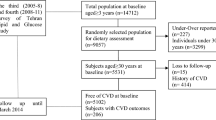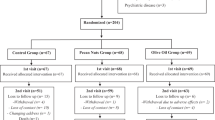Abstract
Objective:
The present study was designed to examine for the first time, side-by-side, the effects of plant sterol and stanol consumption on lipid metabolism and markers of antioxidant status, oxidative stress, endothelial dysfunction and low-grade inflammation in subjects on stable statin–treatment.
Design:
Double-blind, randomized, placebo-controlled, intervention trial.
Setting:
University.
Subjects:
Forty-five patients on current statin treatment were recruited via newspaper advertisements. Data of 41 patients were used in statistical analysis.
Intervention:
Subjects consumed margarine with no added plant sterols or stanols for 4 weeks and were then divided into three groups of 15 subjects. For the next 16 weeks, one group continued with the control margarine and the other two groups with either a plant sterol- or stanol (2.5 g/day)-enriched margarine. Blood was sampled at the end of the run-in and intervention periods.
Results:
Plant sterol and stanol consumption significantly (P=0.026) reduced low-density lipoprotein (LDL) cholesterol by 0.34 mmol/l (95% confidence interval (CI), −0.67 to −0.04 mmol/l). No effects were shown on enzymatic and non-enzymatic antioxidants and markers of oxidative modification of lipids and DNA. In addition, no effect was found on soluble adhesion molecules, C-reactive protein and monocyte chemotactic protein-1 concentrations.
Conclusions:
We conclude that 16 weeks of plant sterol or stanol consumption did not affect markers of antioxidant status, oxidative stress, endothelial dysfunction and low-grade inflammation in patients on stable statin treatment, despite a significant reduction of LDL cholesterol.
This is a preview of subscription content, access via your institution
Access options
Subscribe to this journal
Receive 12 print issues and online access
$259.00 per year
only $21.58 per issue
Buy this article
- Purchase on Springer Link
- Instant access to full article PDF
Prices may be subject to local taxes which are calculated during checkout
Similar content being viewed by others
References
Aebi H (1984). Catalase in vitro. Methods Enzymol 105, 121–126.
Anderson TJ, Uehata A, Gerhard MD, Meredith IT, Knab S, Delagrange D et al. (1995). Close relation of endothelial function in the human coronary and peripheral circulations. J Am Coll Cardiol 26, 1235–1241.
Basu S (1998). Radioimmunoassay of 15-keto-13,14-dihydro-prostaglandin F2alpha: an index for inflammation via cyclooxygenase catalysed lipid peroxidation. Prostaglandins Leukot Essent Fatty Acids 58, 347–352.
Blair SN, Capuzzi DM, Gottlieb SO, Nguyen T, Morgan JM, Cater NB (2000). Incremental reduction of serum total cholesterol and low-density lipoprotein cholesterol with the addition of plant stanol ester-containing spread to statin therapy. Am J Cardiol 86, 46–52.
Bouma M, Laan M, Deneter M, Buurman W (1997). Analysis of soluble adhesion molecules. In: Johnstone A, Turner M (eds). Immunochemistry: A Practical Approach. Oxford University Press: Oxford.
Briede JJ, Godschalk RW, Emans MT, De Kok TM, Van Agen E, Van Maanen J et al. (2004). In vitro and in vivo studies on oxygen free radical and DNA adduct formation in rat lung and liver during benzo[a]pyrene metabolism. Free Radic Res 38, 995–1002.
Cines DB, Pollak ES, Buck CA, Loscalzo J, Zimmerman GA, McEver RP et al. (1998). Endothelial cells in physiology and in the pathophysiology of vascular disorders. Blood 91, 3527–3561.
Comparato C, Altana C, Bellosta S, Baetta R, Paoletti R, Corsini A (2001). Clinically relevant pleiotropic effects of statins: drug properties or effects of profound cholesterol reduction? Nutr Metab Cardiovasc Dis 11, 328–343.
de Jongh S, Vissers MN, Rol P, Bakker HD, Kastelein JJ, Stroes ES (2003). Plant sterols lower LDL cholesterol without improving endothelial function in prepubertal children with familial hypercholesterolaemia. J Inherit Metab Dis 26, 343–351.
Expert panel on detection (2001). Executive summary of the third report of the National Cholesterol Education Program (NCEP) expert panel on detection, evaluation, and treatment of high blood cholesterol in adults (adult treatment panel III). J Am Med Assoc 285, 2486–2497.
Flohe L, Gunzler WA (1984). Assays of glutathione peroxidase. Methods Enzymol 105, 114–121.
Friedewald WT, Levy RI, Fredrickson DS (1972). Estimation of the concentration of low-density lipoprotein cholesterol in plasma, without use of the preparative ultracentrifuge. Clin Chem 18, 499–502.
Granger DN, Vowinkel T, Petnehazy T (2004). Modulation of the inflammatory response in cardiovascular disease. Hypertension 43, 924–931.
Guillen-Sans R, Guzman-Chozas M (1998). The thiobarbituric acid (TBA) reaction in foods: a review. Crit Rev Food Sci Nutr 38, 315–330.
Hallikainen MA, Sarkkinen ES, Gylling H, Erkkila AT, Uusitupa MIJ. (2000). Comparison of the effects of plant sterol ester and plant stanol ester-enriched margarines in lowering serum cholesterol concentrations in hypercholesterolaemic subjects on a low-fat diet. Eur J Clin Nutr 54, 715–725.
Holvoet P, Vanhaecke J, Janssens S, Van de Werf F, Collen D (1998). Oxidized LDL and malondialdehyde-modified LDL in patients with acute coronary syndromes and stable coronary artery disease. Circulation 98, 1487–1494.
Jones P, Kafonek S, Laurora I, Hunninghake D (1998). Comparative dose efficacy study of atorvastatin versus simvastatin, pravastatin, lovastatin, and fluvastatin in patients with hypercholesterolemia (the CURVES study). Am J Cardiol 81, 582–587.
Katan MB, Grundy SM, Jones P, Law M, Miettinen T, Paoletti R (2003). Efficacy and safety of plant stanols and sterols in the management of blood cholesterol levels. Mayo Clin Proc 78, 965–978.
Ketomaki A, Gylling H, Miettinen TA (2004). Effects of plant stanol and sterol esters on serum phytosterols in a family with familial hypercholesterolemia including a homozygous subject. J Lab Clin Med 143, 255–262.
Ketomaki A, Gylling H, Miettinen TA (2005). Non-cholesterol sterols in serum, lipoproteins, and red cells in statin-treated FH subjects off and on plant stanol and sterol ester spreads. Clin Chim Acta 353, 75–86.
Kirkova M, Atanassova M, Russanov E (1999). Effects of cimetidine and its metal complexes on nitroblue tetrazolium and ferricytochrome c reduction by superoxide radicals. Gen Pharmacol 33, 271–276.
Landmesser U, Hornig B, Drexler H (2000). Endothelial dysfunction in hypercholesterolemia: mechanisms, pathophysiological importance, and therapeutic interventions. Semin Thromb Hemost 26, 529–537.
Leeuwenberg JF, Smeets EF, Neefjes JJ, Shaffer MA, Cinek T, Jeunhomme TM et al. (1992). E-selectin and intercellular adhesion molecule-1 are released by activated human endothelial cells in vitro. Immunology 77, 543–549.
Lepage G, Munoz G, Champagne J, Roy CC (1991). Preparative steps necessary for the accurate measurement of malondialdehyde by high-performance liquid chromatography. Anal Biochem 197, 277–283.
Liao JK, Laufs U (2005). Pleiotropic effects of statins. Annu Rev Pharmacol Toxicol 45, 89–118.
Normen L, Dutta P, Lia A, Andersson H (2000). Soy sterol esters and beta-sitostanol ester as inhibitors of cholesterol absorption in human small bowel. Am J Clin Nutr 71, 908–913.
Paglia DE, Valentine WN (1967). Studies on the quantitative and qualitative characterization of erythrocyte glutathione peroxidase. J Lab Clin Med 70, 158–169.
Peter K, Nawroth P, Conradt C, Nordt T, Weiss T, Boehme M et al. (1997). Circulating vascular cell adhesion molecule-1 correlates with the extent of human atherosclerosis in contrast to circulating intercellular adhesion molecule-1, E-selectin, P-selectin, and thrombomodulin. Arterioscler Thromb Vasc Biol 17, 505–512.
Plat J, Mensink RP (2000). Vegetable oil based versus wood based stanol ester mixtures: effects on serum lipids and hemostatic factors in non-hypercholesterolemic subjects. Atherosclerosis 148, 101–112.
Plat J, Mensink RP (2001). Effects of diets enriched with two different plant sterol ester mixtures on plasma ubiquinol-10 and fat-soluble antioxidant concentrations. Metabolism 50, 520–529.
Plat J, Mensink RP (2002a). Effects of plant stanol esters on LDL receptor protein expression and on LDL receptor and HMG-CoA reductase mRNA expression in mononuclear blood cells of healthy men and women. FASEB 16, 258–260.
Plat J, Mensink RP (2002b). Increased intestinal ABCA1 expression contributes to the decrease in cholesterol absorption after plant stanol consumption. FASEB J 16, 1248–1253.
Ridker PM, Hennekens CH, Buring JE, Rifai N (2000). C-reactive protein and other markers of inflammation in the prediction of cardiovascular disease in women. New Engl J Med 342, 836–843.
Ross R (1999). Atherosclerosis – an inflammatory disease. New Engl J Med 340, 115–126.
Vasankari T, Ahotupa M, Viikari J, Nuotio I, Strandberg T, Vanhanen H et al. (2004). Effect of 12-month statin therapy on antioxidant potential of LDL and serum antioxidant vitamin concentrations. Ann Med 36, 618–622.
West SG (2001). Effect of diet on vascular reactivity: an emerging marker for vascular risk. Curr Atheroscler Rep 3, 446–455.
Weststrate JA, Meijer GW (1998). Plant sterol-enriched margarines and reduction of plasma total- and LDL-cholesterol concentrations in normocholesterolaemic and mildly hypercholesterolaemic subjects. Eur J Clin Nutr 52, 334–343.
Zhao G, Etherton TD, Martin KR, West SG, Gillies PJ, Kris-Etherton PM (2004). Dietary alpha-linolenic acid reduces inflammatory and lipid cardiovascular risk factors in hypercholesterolemic men and women. J Nutr 134, 2991–2997.
Acknowledgements
We thank Mirjam Heinen for dietary support, Frank Cox and Maurice Kunen for technical support and Marjolijn Bragt for performing the ELISAs and LDL-receptor analyses. We also thank Arnold Kester for support on the statistical analyses. We thank Raisio Group (Raisio, Finland) for kindly providing us with all the margarines.
This work was sponsored by the Netherlands Organization for Health Research and Development (Program Nutrition: Health, Safety and Sustainability, Grant 014-12-010).
Author information
Authors and Affiliations
Corresponding author
Additional information
Guarantor: J Plat.
Contributors: AJ conducted the study and statistically analysed the data. RPM and JP designed and supervised the study. AB was responsible for the analyses of the enzymatic antioxidants and MDA. RWLG conducted the 8-oxo-dG analysis. SB was responsible for the analysis of 15-PDGH. All authors contributed to the writing of the paper.
Rights and permissions
About this article
Cite this article
De Jong, A., Plat, J., Bast, A. et al. Effects of plant sterol and stanol ester consumption on lipid metabolism, antioxidant status and markers of oxidative stress, endothelial function and low-grade inflammation in patients on current statin treatment. Eur J Clin Nutr 62, 263–273 (2008). https://doi.org/10.1038/sj.ejcn.1602733
Received:
Revised:
Accepted:
Published:
Issue Date:
DOI: https://doi.org/10.1038/sj.ejcn.1602733
Keywords
This article is cited by
-
Winter food selection and exploratory behavior vary with natal territory characteristics in wild great tits
Behavioral Ecology and Sociobiology (2023)
-
Phytosterol compositions of enriched products influence their cholesterol-lowering efficacy: a meta-analysis of randomized controlled trials
European Journal of Clinical Nutrition (2019)
-
Individual foraging preferences are linked to innovativeness and personality in the great tit
Behavioral Ecology and Sociobiology (2017)
-
Effects of plant stanol or sterol-enriched diets on lipid profiles in patients treated with statins: systematic review and meta-analysis
Scientific Reports (2016)
-
Consumption of a dietary portfolio of cholesterol lowering foods improves blood lipids without affecting concentrations of fat soluble compounds
Nutrition Journal (2014)



